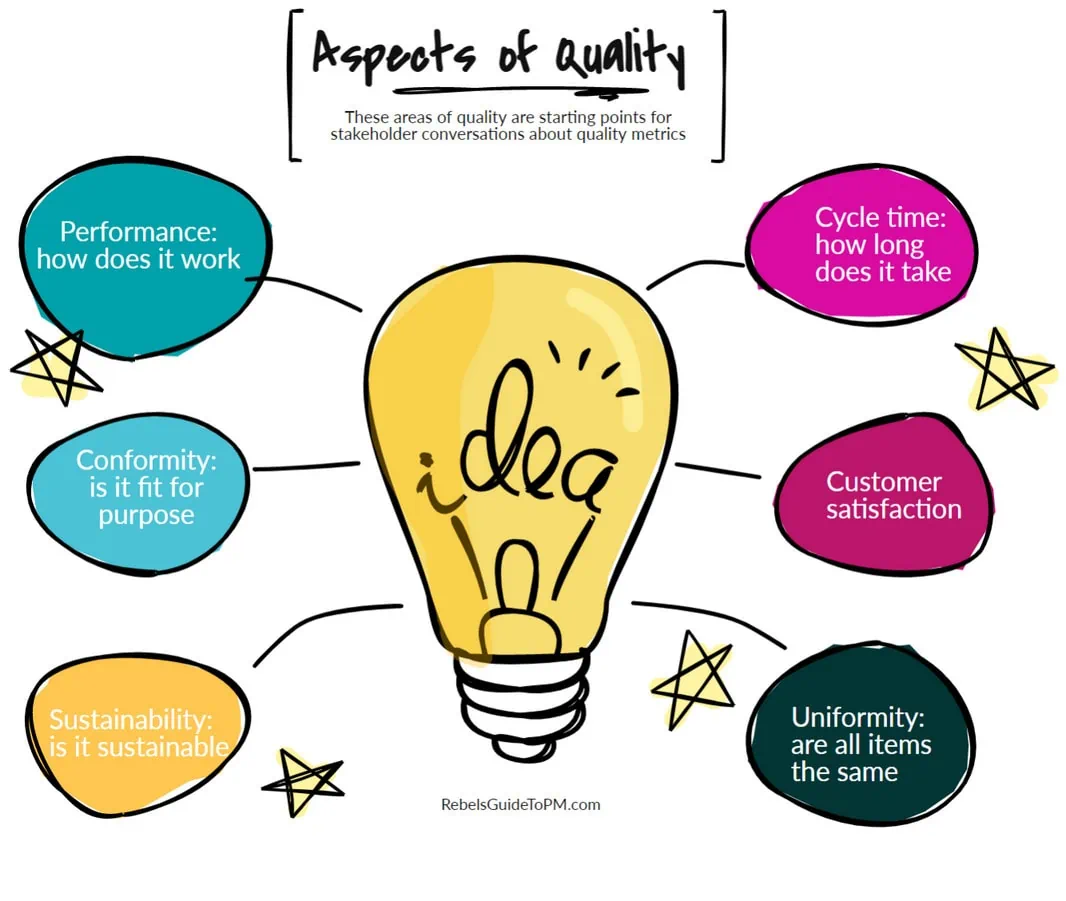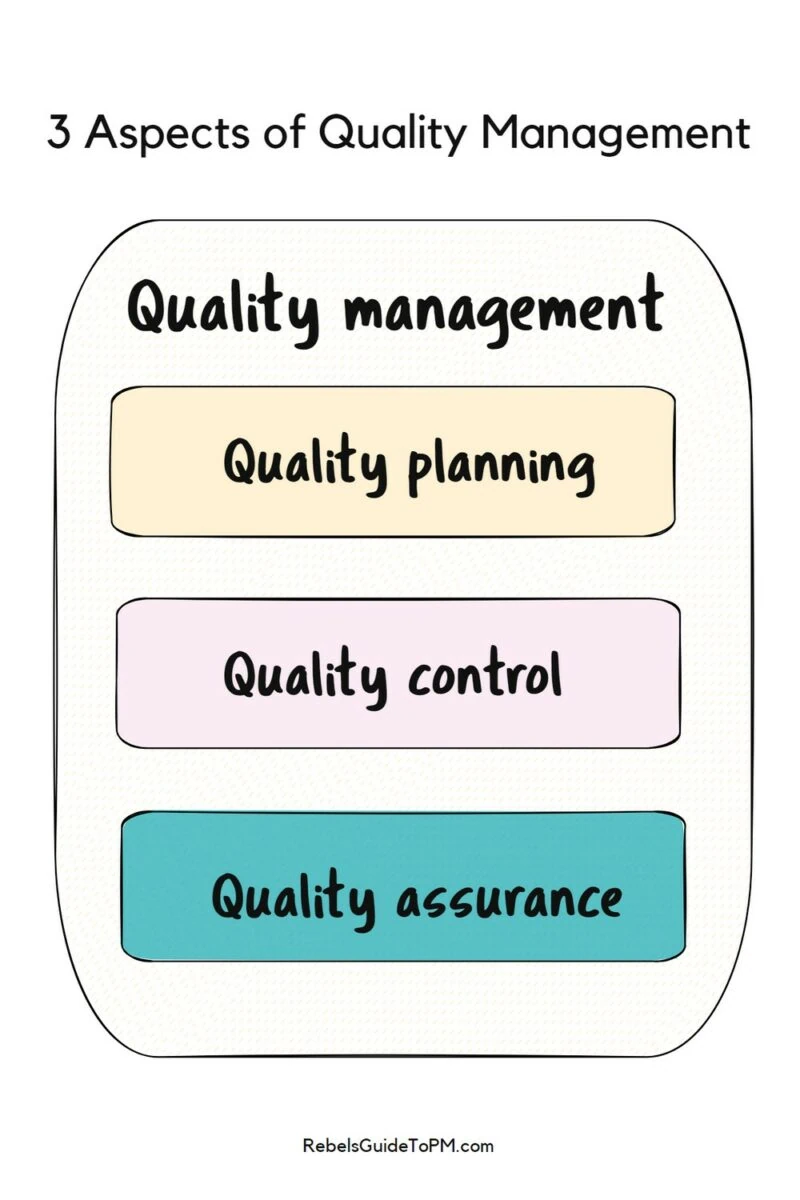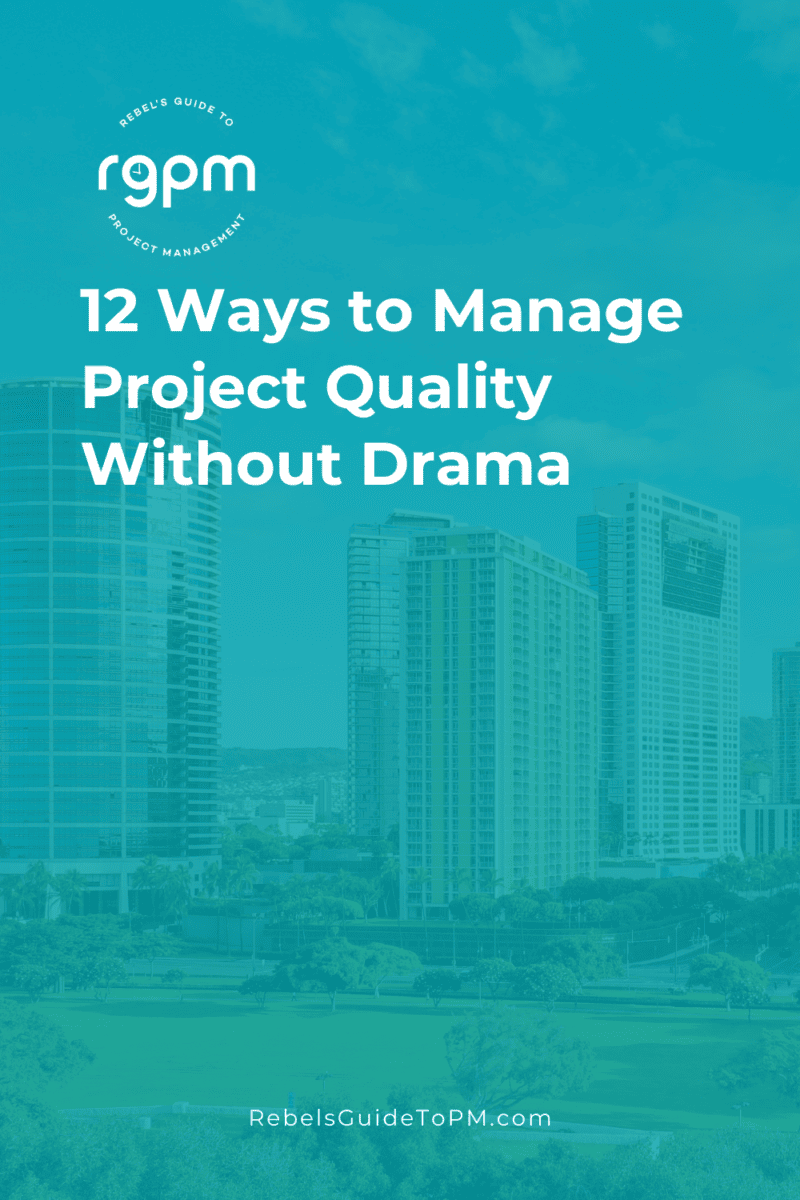12 Ways to Manage Project Quality Without Drama
This blog is reader-supported. When you purchase something through an affiliate link on this site, I may earn some coffee money. Thanks! Learn more.
Everyone wants their projects to be “quality” but I often get asked about how to manage project quality in real life.
What does it mean to “do” project quality?
You probably already know that you need a quality management plan, and that management, assurance and control are the pillars of doing it right.
But in practice, to me that looks like a lot of project documentation, and not a lot of actual doing, so let’s talk about 12 simple ways that you can manage project quality, without it being loads of work or a drama to get right.
The basics: defining quality
Knowing how you are going to manage quality feeds into your quality plan (obviously). You’ll also need to know how you are going to assure project quality. But all that really comes after knowing what quality looks like on your project.
The APM Body Of Knowledge (BOK) defines project quality as:
“The fitness for purpose of the degree of conformance of the outputs of a process, or the process itself to requirements.”
Association for Project Management Body of Knowledge 7th Edition
In other words, your quality management work is all about making sure that what you deliver is good enough for the job it was designed to do.
While definitions of quality vary between professional organizations, they all have “being fit for purpose” as a common theme. The ISO 9001 definition is very similar to APM’s, as is the definition in the PMI PMBOK®.
You can create your own definition if you want, but “fit for purpose” works for us.
OK, with that out the way, let’s get on to how you can create the right level of quality with a practical approach.
1. Start with the project requirements
What is your project actually doing, building, making, delivering?
That’s where you start. Make sure you have a list of project requirements.
It doesn’t matter if you are
This bit is pretty easy.

2. Know what good looks like
For each requirement, make sure you and the team know what good looks like for each item. “Good” then becomes your success criteria or quality measures.
“Good” could be:
- The buttons are green
- The process takes less than 3 seconds
- Latency is 0.1 seconds
- Each widget is 30 cm by 15 cm and weighs 62.5g with a permitted variance of +/- 0.25g, with 3 widgets sampled each month by the Quality Manager
Or whatever makes sense for you.
Include non-functional requirements as well as the things stakeholders ask about as features.
These should be measures where you can pass or fail an item, so avoid quality criteria like, “The team thinks the solution is great,” where you can’t easily measure objectively.
If you want to use subjective measures, think about how you could survey the team in this scenario. Your criteria could be: “When asked what they think of the process, 80% of team members rate it as Very Good or Great 6 weeks after implementation.”
Document criteria in your quality plan, which is part of your project management plan.
3. Define how often you will check quality
Next, define how often you will check that the deliverables are meeting the quality criteria.
The options are:
- Once (i.e. at completion)
- Every x weeks/days/months (e.g. if you are sampling products from a production line)
Think about what makes sense in the context of your project AND won’t create too much of an overhead for the team. Don’t set yourselves up to have to do quality checking every week when it would be just as good to do it quarterly!
4. Book quality checks
Now you know what project quality measures you are trying to hit, book some quality checks in. Put the time in the calendar or add the tasks to your plan during the project execution phase.
Use this time for checking and inspection, in line with the timelines you thought were appropriate.
This ticks the box for the quality control process, which is about making sure errors and defects don’t make it to the end customer.
Also, if you have internal auditors or a Quality Assurance function, or someone in the PMO who can do an informal (or formal) project review, book that in as well. Use their expertise to help improve your processes, methods and ways of working.
Quality assurance reviews, peer reviews, health checks and quality audits might sound scary for project managers – they’re not. I’ve been through lots, even with external auditors, and it’s an effort to prepare everything, but it’s nothing to be worried about.
The goal is to identify what you are doing well so you know to keep doing it, and to identify where you could improve how the project is managed to get even better results.
OK, no one likes to be told they aren’t doing 100% brilliantly, but in reality, who amongst us really is? I know I’m not 100% amazing at every aspect of project management, partly because I don’t have time to do everything with the degree of attention I’d like.
At least with an audit, someone tells you what to do to be better so you can easily switch up your working practices without having to work it all out yourself.

5. Schedule testing
If you’re not making a physical thing (or even if you are), book in some testing time.
In my experience, the testing phase is always squeezed because development/build takes longer than expected. Make sure you leave enough time for testing.
I would recommend 3 rounds of testing and bug fixing, each should be shorter so by the time you get to round 3 it’s really about verifying that the fixes worked and no new corrective action requirements are identified.
That’s just a guideline: use whatever your company software development lifecycle specifies or what works until you have working software you are happy to ship. But for planning purposes, in the absence of any other information, I would plan for 3 rounds.
Tip: Make sure you have the project management tools and testing software that make your life easier. If you don’t have the right tools to do the job, it’s much harder to deliver a successful project. Add project management software or testing tools (or whatever else you need) to the project budget.
6. Allocate enough time to do quality work
Quality assurance is about making sure that the work done is a good standard, and you end up with shoddy work if you don’t have the time to do it properly.
Make sure that you are thinking realistically about estimates and the likelihood of risk affecting your ability to deliver.
Consider adding contingency time to the schedule if your project is unusual or innovative (for your organization). You don’t want people squashed for time and taking shortcuts as that’s how you end up with low standards and a lower quality deliverable.
Tip: Avoid scope creep! Scope creep is one of the ways that lower quality deliverables sneak into the project. Unapproved requirements also pull people on to different tasks that are not their core work, so they have less time to deliver the project scope that has been approved.
7. Allocate people to do quality work
Make sure you have enough people in the project team to create a quality outcome. For example, we use pair programming to ensure that software errors are less likely to make it into the final version and that the quality of the code is as good as it can be.
Pair up resources, make sure less experienced team members have mentors. For example, you might need more experienced people at the beginning to do the design, but junior members of the team could do the execution following their instructions.
Choose the right resources for the job, matching what they need to do to their skills.
8. Allow time for training
People with training and experience do a better job than people without.
But, projects rarely have dedicated budgets for training. When you are putting your budget together, think about what training the team would benefit from so they could be better at doing the work.
Training could include technical skills. For example, on one project we were using consultants to do some software configuration and set up but we needed our own employees to be able to do those tasks in the long term. We identified the right people and made sure they had training from the official vendor on how to carry out those tasks.
Training could also include soft/power skills. For example, I did a conflict resolution course, or you might feel that people could benefit from facilitation training if there is going to be a lot of workshops to run on this project.

9. Be flexible
You set quality acceptance criteria at the outset, but you can afford to be a bit flexible in certain situations. Obviously, if safety is a concern, then no, don’t be flexible.
But if you’re thinking about software bugs, for example, you might agree that your original quality criteria of zero bugs is a bit unrealistic and that users could cope with having three clicks instead of one to get to a feature and you can fix it later.
Use the lessons learned process or retrospective conversations to think about how you could improve, change or tweak what you are doing to keep a focus on quality without holding up anything else. Feed into future projects as well, so other project managers benefit from your experience.
10. Follow the processes
Another very easy, no-drama way to keep a focus on quality is to simply follow your project management methodology and processes consistently, throughout the project lifecycle.
Whatever processes are set in your organization, or for your project, stick to them. They exist for a reason! Keep the focus on following published quality standards and good practice to get consistent results.
Hold the team accountable for following processes and make it easy for them to do their job in the right way. Use checklists, standard operating procedures, automations and workflows to keep tasks done in a standard way.
11. Budget for quality
Project cost is normally based on what you need to complete the deliverables, and sometimes project activities for quality are not included.
Work out the cost for the quality requirements. What will it take to put in place quality processes? Do you need to hire a Quality Manager? What budget is necessary to get really high-quality project deliverables? Because you know what quality looks like, so you should be able to cost up what it will take to get there.
12. Track quality
Great, you are measuring quality. Now you have to communicate the results to the team.
Set up project dashboards to share the outputs of audits, testing and checks. Effective, frequent communication will let everyone know how close you are to hitting those quality targets and what corrective action might be required to get back on track if you are falling short.
If it’s appropriate, create some quality reports, but most projects can do without dedicated additional reporting if you’ve got the quality metrics covered off somewhere else.
Your next steps
There is a lot to project quality, but if you follow the simple steps above, you will find managing projects with quality in mind becomes a lot easier.
Focus on putting the groundwork in place to set your project up for success, keep the project on track, and involve stakeholders so they know what to expect.
- Create your quality plan.
- Talk to your team and project sponsor about quality and how it is going to be measured on this project.
- Get started with the tips above to build quality into how you manage and deliver the project.
